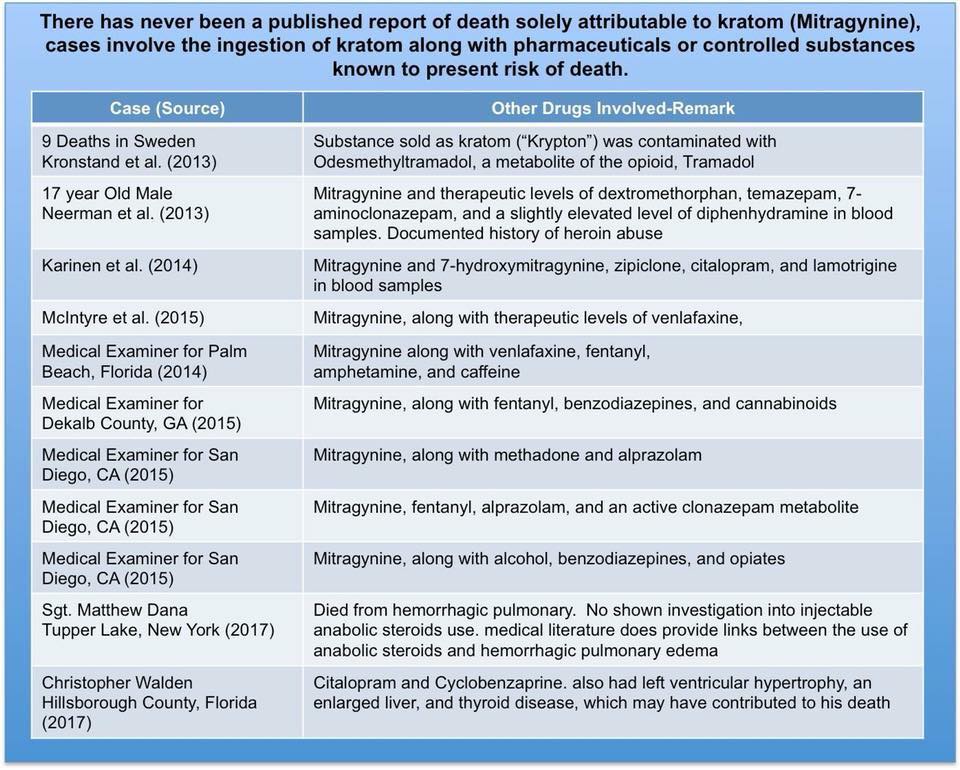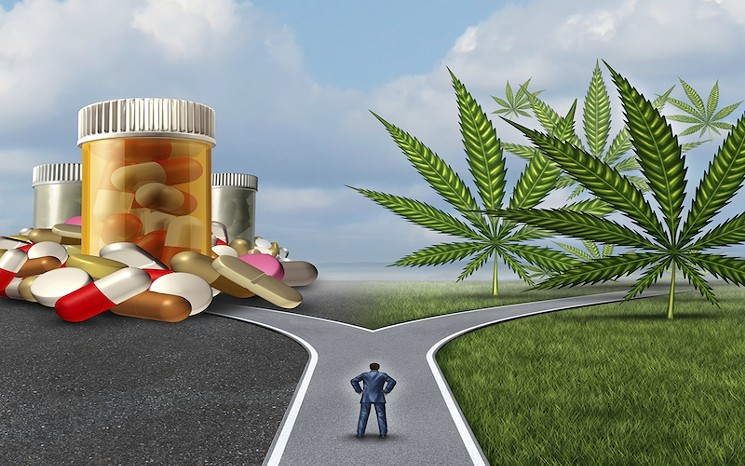Written by: John Bush, CEO MyBraveBotanicals.com
With the opioid use on the rise in the United States, more and more Americans are turning to kratom to help overcome opiate addiction. Kratom is made from the ground up leaves of the kratom evergreen tree, a member of the coffee family grown primarily in Southeast Asia. Many users report taking kratom as an alternative to prescription pain medication and others use it to minimize withdrawal symptoms, helping them to quit opiates once and for all.

Picture from a local Tennessee news story on the FDA Health Advisory
This increase in kratom use has caught the attention of the Food and Drug Administration. In a November 14th Public Health Advisory, FDA Commissioner Scott Gottlieb M.D. claims, “the FDA is aware of reports of 36 deaths associated with the use of kratom containing products.” The advisory goes on to state that, “Over the past several years, kratom has raised significant concerns given its increasing prevalence and potential safety risks.”
While the FDA and other government agencies convey kratom as a harmful substance with no evidence of any medical use, there exists a great deal of research and anecdotal evidence that indicates kratom does indeed have a number of positive health benefits. A number of studies have concluded that kratom has an analgesic effect, meaning it relieves pain, and that kratom may be a viable alternative with fewer side effects than opioid based pain medications. A study from July of 2017 concluded that kratom can be, “used for self-treatment of pain, mood disorders, and withdrawal symptoms associated with prescription opioid use”. In 2012, a pharmacological study found similar conclusions stating that, “Kratom and kratom-derived drugs may potentially be used for the management of pain, opioid withdrawal symptoms, and other clinical problems.”
A recent survey of over 6,000 kratom users conducted by the Pain News Network (PNN) and the American Kratom Association (AKA) found that 51% of kratom consumers take kratom for treatment of chronic pain, 14% use kratom for treatment of anxiety, and 9% use kratom for treatment of opioid addiction.
If so many lives are improved by taking kratom and there exists many scientific studies that show kratom to be safe and beneficial, why would the FDA want to make it harder for Americans to access this natural plant? Why is so much misinformation being peddled by the Food and Drug Adminstration? Is it possible that large pharmaceutical companies have influence over the FDA and fear that kratom will hurt their bottom line? Should the FDA have the authority to regulate a naturally growing plant? What does the recent Health Advisory mean for your ability to access kratom in the future?
We will answer these question and more in this Brave Botanicals Special Report – Kratom Under Attack: the FDA Strikes Again.
The FDA’s Claims Are Lacking Intellectual Rigor
In the FDA’s Health Advisory, Commissioner Scott Gottlieb makes several unsubstantiated claims in regards to kratom’s potential medical risks and alleged lack of health benefits. Perhaps the most alarming claim, which in turn was included in a variety of mainstream news headlines, is that the FDA is aware of “36 deaths associated with the use of kratom-containing products.” This is a number that is substantially higher than the Drug Enforcement Agency’s claim in their 2016 announcement of their intent to schedule kratom, that between 2014 and 2016 there were 15 kratom-related deaths. In both the FDA Health Advisory and the DEA Announcement of Intent to Schedule, the sources for those claims are nonexistent. There are no references whatsoever, yet the media is content to run with outrageous and alarming headlines without doing the least bit of fact-checking.

In a large majority of kratom-related deaths there are other substances or medical conditions involved that are likely the true cause of death. As reported in an 8-Factor Potential Abuse Assessment on Kratom, commissioned by the American Kratom Association, Dr. Jack Henningfield found that, “among the 3-4 publicly documented deaths that have ever been suspected to possibly have involved the consumption of kratom, none have been shown to merit designation as a kratom overdose death and all have involved either other substances or physical or mental health conditions that may have been the primary causes of, or significant contributors to, the death.” The FDA Health Advisory fails to mention this critical information and “journalists” who reported on the advisory neglected to look beneath the surface.

For many in the kratom community, kratom is seen as a tool for harm reduction. Even if some of the 36 kratom-related deaths were caused by kratom alone, when compared to the 183,000 prescription opioid deaths from 1999 to 2015, kratom isn’t nearly as dangerous. As previously mentioned, a PNN and AKA kratom survey found that of the 51% of kratom users take kratom for treatment of acute or chronic pain. When asked what those kratom users would do if kratom were to be banned in the United States, one-in-five respondents said they would use “something else”. Two-thirds of those who would use “something else” said they would use prescription drugs. Judging from the number of deaths from prescription opioids, it would seem that banning or making it harder for consumers to access kratom would likely result in a greater incidence of harm and possibly death.
The Health Advisory also states that, “the use of kratom is also associated with serious side effects like seizures, liver damage and withdrawal symptoms.” Again, the advisory contains no source material whatsoever to back up these claims. Initial research in regards to kratom-related seizures turns up only three documented instances presented in medical journals. One of the instances is a case where an 85 year old man had a seizure and became comatose after consuming a kratom tea that contained datura stramonioum, also known as “devil’s weed”, a plant that is taken by some as a hallucinogen.
Liver damage is a side effect often cited by kratom opponents. Studies and research indicating that kratom leads to liver damage is very minimal and more often than not the scientists conducting the research indicate that only in chronic high doses of kratom can liver damage occur. A study examining the potential for liver injuries caused by the three Ks (kava, kratom, and khat) stated that, “chronic recreational use of kratom has been associated with rare instances of acute liver injury.” The study examines a large number of studies done on rats, however when it came to humans, “authors of both studies due to the lack of scientific data on the toxicity of kratom in humans, were cautious in confirming unequivocally this association; in the first case the physicians could not directly correlate the onset of acute liver disease with the intake of kratom.” While these scientists and doctors were hesitant to link liver toxicity to kratom intake, Commissioner Scott Gottlieb had no problem including such an assertion in his Health Advisory and media outlets were quick to include it in their new stories.
According to the previously mentioned research conducted by Dr. Jack Henningfield, while evidence does suggest that kratom can cause withdrawal symptoms, the effects are similar to withdrawals from caffeine or nicotine and primarily occur when someone is chronically consuming an extremely high dose of kratom. Many kratom vendors advise their customers to take kratom in moderation and to take regular breaks from the remedy so as not to develop a high tolerance. As with most of the potential for harm when it comes to kratom, risk of withdrawals can be minimized when consumers exercise personal responsibility and use kratom in moderation.
Genuine Kratom Concerns Can Be Resolved Through Personal Responsibility
There are two concerns laid out in the advisory that the author of this report recommends readers take seriously. The advisory states that, “Patients addicted to opioids are using kratom without dependable instructions for use and more importantly, without consultation with a licensed health care provider about the product’s dangers, potential side effects or interactions with other drugs.” (As we shall see later in the report, the FDA is concerned with a lack of dependable instructions on kratom packages yet they disincentivize vendors from including such information on their products) While many doctors may be unfamiliar or agnostic about kratom, it is important for patients to do their due diligence and check with their physician about possible problems should they start taking kratom along with their existing medication. This is especially the case since many pharmaceuticals are quite taxing on the liver. Combining kratom with some of these medications could cause problems.
It is worth mentioning however that it’s always a good idea to do your own research and to seek a second opinion. Just because a credentialed doctor says one thing does not mean it is necessarily the best course of action. Also, be aware that some doctors receive kickbacks and special privileges for pushing pharmaceuticals on their patients and may not take lightly a request for information about kratom or a patient’s desire to consume the plant.
The other area of concern for kratom consumers is noted in the advisory when Dr. Gottlieb writes, “there have been reports of kratom being laced with other opioids like hydrocodone.” It is possible when buying from an unknown vendor that there may be other substances in your powder besides kratom. This concern can be easily overcome by only purchasing kratom from reliable sources with great reviews and a dependable reputation. Forums on the internet and groups on Facebook are great source for finding references for reputable vendors.
When it comes to the adverse health claims put forward in the FDA Health Advisory, it is clear they are severely lacking evidence and merit. Those concerns that are significant are easily managed when consumers exercise personal responsibility by not chronically taking large amounts of kratom and by doing your due diligence when it comes to choosing a kratom vendor.
How did the FDA gain so much power and influence over what Americans can and cannot put in their bodies? As we will discover, things were not always that way in this country. The American system of law and governance has been flipped upside down, leaving a vast amount of power in the hands of the government at the expense of the people.
Island of Rights in a Sea of Privileges
American legal and political institutions were originally built upon the constitutional principle of English law that “Everything which is not forbidden is allowed.” This can be visualized by imagining a vast sea that represents your rights, activities you are free to engage in that don’t harm others or interfere with another’s rights, and in the middle of the sea is a tiny island of privileges, activities which are regulated or permission from the government is needed to engage in said activities.

Over the course of American History, this legal framework has been flipped on it’s head. We now have a vast see of privileges and a tiny sea of rights. This opposite doctrine is known in English Law as “Everything which is not allowed is forbidden.” While this phenomenon was originally intended to apply to government agencies and public officials, it has since been applied to just about every facet of American life. In the case of the FDA, if a particular substance, medicine, or remedy is said to have a medical benefit, and is not approved by the FDA, then it is considered prohibited. Even if it happens to be an abundantly growing tree like kratom or a weed like cannabis.
Efforts to have kratom approved as a dietary supplement by the FDA have not been successful. As recently as May 2015, a kratom vendor submitted a new dietary ingredient notification to the FDA. In their response, the FDA stated that the submission was “glaringly insufficient.” This particular submission was for a kratom extract and was lacking many of the requirements to meet the standards laid out by the FDA. While this attempt was a failure, another vendor may be able to successfully navigate the FDA requirements to have kratom approved as a dietary supplement.
The FDA’s use of the “Everything which is not allowed is prohibited” legal doctrine has led to a dangerous trap. The FDA’s mission is to “protect the public health”, yet the perverse disincentives they create by prohibiting the sale of kratom as a dietary supplement deters vendors from including suggested serving sizes on their packaging, thus increasing the risk of adverse effects related to improper kratom consumption.
Due to fear that their business might be shut down and their products seized, many kratom vendors are leaving leaving off of their packaging important information such as supplement facts and suggested serving size. Organizations like The Botanical Education Alliance have recommended that vendors comply with FDA labeling requirements, however some vendors choose not to out of concern they will come under fire from the FDA. As a result, a great deal of kratom is sold simply as a powder with no specific use found on the packaging. In an effort to avoid scrutiny, some vendors take it a step further labeling their product as “not for human consumption” or for “experimental purposes only”. Additionally, some vendors label the kratom as a material used for making soap. When a package is lacking appropriate information regarding serving size it leaves open the possibility that consumers will take too much at once which may lead to nausea or vomiting.
This is ironic as the recent FDA Health Advisory states that, “Patients addicted to opioids are using kratom without dependable instructions for use and more importantly, without consultation with a licensed health care provider about the product’s dangers, potential side effects or iterations with other drugs.” It is clear the FDA would prefer kratom vendors include information about servings size, yet doing so would invariably increase the risk that those vendors could be shut down.
When government agencies use control and coercion to manipulate markets, it often creates unnatural incentives and disincentives which can have unintended consequences.
Perhaps these consequences were intended all along?
The Revolving Door and Shutting Down Competition: How Government Works
While many people think regulatory agencies are necessary to protect consumers and uphold the “greater good”, when one takes a look beneath the surface you find that most regulatory agencies don’t serve to protect consumers, rather they exist to preserve the market dominance of major industry players. In his book, Making Economic Sense, libertarian philosopher Murray Rothbard wrote, “we often fail to realize that the point of Big Government is precisely to set up such ‘partnerships,’ for the benefit of both government and business, or rather, of certain business firms and groups that happen to be in political favor.” This is most certainly the case with the Food and Drug Administration and the current Trump appointed Commissioner, Dr. Scott Gottlieb.
According to an article in Wired Magazine, “Gottlieb’s deep ties to the industry he would regulate go back more than decade, and he currently serves on the board of three pharmaceutical companies. His venture capital firm, new Enterprise Associates, funds 150 others. Gottlieb received more than $400,000 from Big Pharma between 2013 and 2015.” It is these deep financial ties to the pharmaceutical industry that should immediately call into question the credibility of Dr. Scott Gottlieb when it comes to his scrutiny of kratom.
For those thinking this is a problem stemming from the current Republican controlled administration, unfortunately for We the People, the “revolving door” is a bipartisan practice. According to a disclosure statement from the Duke Clinical Research Institute, where Obama appointee Robert Califf worked before becoming FDA Commissioner, Califf received money from 23 drug companies including giants like Johnson & Johnson, Lilly, Merck, Schering Plough and GSK.

What exactly is the “revolving door”? The revolving door is a phenomenon that is all too prevalent in American politics. It happens when high level industry executives and benefactors go from the private sector to public offices and public sector regulatory agencies that are tasked with regulating the very industries that the former executives and industry tycoons are leaving. While these newly appointed regulators more often than not give up their shares in companies and resign from private sector boards during their public sector tenure, upon completing their stint in government, these individuals often return to their private sector positions to reap the benefits of the policies they created while in public office.
How do regulatory policies benefit big business? Most regulations, while appearing to serve the public interest, in reality make it more difficult for smaller firms with minimal staff and lighter budgets to keep up with the new red tape, paperwork, and licensing. Large businesses have teams of lawyers and accountants that can readily deal with any new regulations that may arise. According to research done at Lafayette University, “regulatory compliance exerts a disproportionately large burden on small companies because the fixed costs of adhering to rules can be spread out over more revenue in large firms than in small ones.” Nicole and Mark Crain, the authors of the research, point out that, “the per employee cost of complying with Federal regulations at $10,585 for businesses with fewer than 20 employees but only $7,755 for businesses with more than 499 workers.”
Additionally, when it comes to weeding out competition, some agencies will attempt to outright ban certain products and substances. Such is the case with cannabis at the federal level and last year’s effort to ban kratom. This also rings true to for the automobile industry where regulations in Texas have made it impossible to sell Tesla electric cars.
When it comes to naturally grown plants like cannabis and kratom, pharmaceutical companies are not able to make a profit off of the substances as they are so widely available in the wild and easy to grow at home. While it is not known how how many people are taking kratom in lieu of prescription painkillers, as the kratom industry continues to grow exponentially, it is likely that kratom will continue to take business away from large pharmaceutical companies. It is estimated that the American kratom industry does more than $5 billion dollars in annual revenue. When compared to the $24 billion dollars a year in revenue pharmaceutical companies receive from the sale of prescription pain medication, kratom is giving Big Pharma a run for their money!

The pharmaceutical industry is definitely taking notice. While federal agencies are making it harder or impossible to access cannabis and kratom, pharmaceutical companies are working to synthesize their active compounds and alkaloids, patent them, and profit from the sale of these new synthetic drugs. While the Federal Government claims there is no medical use for cannabis and the plant is illegal at the federal level, the DEA recently authorized Insys Therapeutics, a major pharmaceutical company, to obtain a patent on a synthetic marijuana drug. Not surprisingly, this same company also spent $500,000 in 2016 to combat an Arizona referendum that would have legalized marijuana in that State. The referendum lost with 51.32% opposing legalization and 48.68% in favor. Insys Therapeutic’s monetary contribution to the opposition campaign accounted for 10% of the money raised.
Are you beginning to see how this works?
This same political phenomenon is occurring in the kratom world. As stated in an article from the Free Thought Project, “three synthetic opioids, in particular, were synthesized from the alkaloids in kratom from 2008- 2016: MGM-9, MGM-15, and MGM-16. They were synthesized from kratom’s alkaloids Mitragynine and 7-Hydroxymitragynine: to make what is essentially patentable, pharmaceutical kratom.” This is definitely a cause for concern and illustrates the hypocrisy of the Federal Government which simultaneously seeks to prohibit the use of kratom while using patents to grant private companies a monopoly on the future manufacture and sale of a synthetic form of kratom.
At the end of the day, even those that are popularly elected or appointed by politicians, act in self interest. It is unfortunate when this self-interest interferes with American’s access to natural health care remedies and innovative technologies.
How Will The Health Advisory Affect My Ability to Buy Kratom in the United States?
This Health Advisory is not the first time the Federal Government has sought to make it harder for Americans to obtain and consume kratom. In 2016, the Drug Enforcement Agency attempted to have kratom listed as a Schedule 1 substance, an action which would have made possession and distribution of kratom a federal felony. Their plans were thwarted due to a massive groundswell of activism and industry support. As a result of the kratom community’s efforts, over 50 United States Congressmen and 10 Senators called on the DEA to back off of their ban. While the victory was widely celebrated, kratom advocates knew the war was far from over. It’s been just over a year later and we now see the FDA making a concerted effort to hinder access to this amazing plant.
So what effect might this Health Advisory and renewed effort to regulate kratom have on kratom as a whole and specifically your ability to access the plant? When one examines the news coverage in the wake of the advisory, with headlines such as FDA warns of injury, death with herbal supplement kratom and FDA warns of ‘deadly risks’ of the herb kratom, citing 36 deaths, it may appear as though those who are kratom-curious may shy away from trying the powder for the first time. While this may be an indirect goal of the FDA, more often than not this tactic backfires as once again kratom is being talked about all across the country.

Source: Google Trends
Just as we saw in the wake of the DEA’s attempt to ban kratom, this level of exposure may in fact encourage more people to try the plant. This is especially the case as people’s faith and trust in government and regulatory agencies are at historic lows. When examining the lack of substance found in the FDA’s Health Advisory, it is no wonder fewer and fewer people trust the government.

Source: Pew Research Center
In the advisory, Commissioner Gottlieb indicates that, “we are working to actively prevent shipments of kratom from entering the U.S.” He also cites two previous import alerts, from 2012 and 2014, where the FDA directed U.S. Marshals and customs officials to seize packages that contain kratom. Kratom itself is not prohibited at the federal level and besides seven States (Arkansas, Alabama, Tennessee, Indiana, Wisconsin, Vermont, and Rhode Island), it is completely legal and mostly unregulated.

Nonetheless, it is apparent the FDA and other federal agencies are stepping up their efforts to seize kratom as it enters the U.S. This will likely have an effect on the U.S. kratom market, possibly making it harder for consumers to access kratom. As a result of a smaller supply and greater risk falling on vendors, this may also increase prices. However, with the large volume of kratom that enters the country each and every day, it is hard to fathom that the FDA’s efforts will stop kratom from entering the country altogether.
So What Now?
In light of the recent health advisory, propaganda campaigns, and increased efforts to regulate kratom and hinder its flow into the country, now is the time to get active in the fight to keep kratom legal.
Call your elected representatives and tell them to keep kratom free. Educate your friends and family about kratom’s many uses and benefits. Join local and national kratom Facebook Groups and support organizations such as the American Kratom Association and the Botanical Education Alliance.
The kratom community defeated the DEA’s attempt at banning kratom in the past, and there is no reason why the kratom community cannot defeat the FDA’s efforts as well.
With truth and history on our side, there is no stopping us.
May the kratom be with you!




